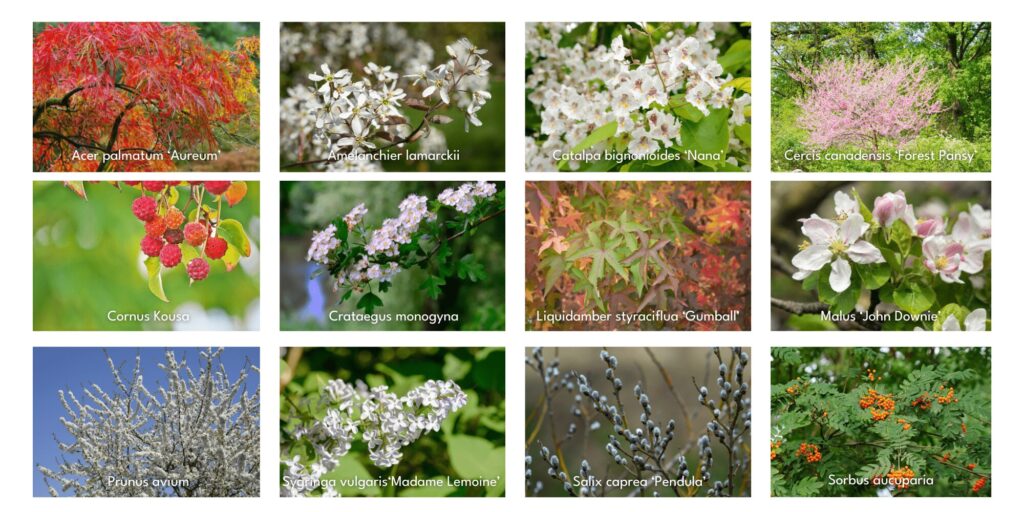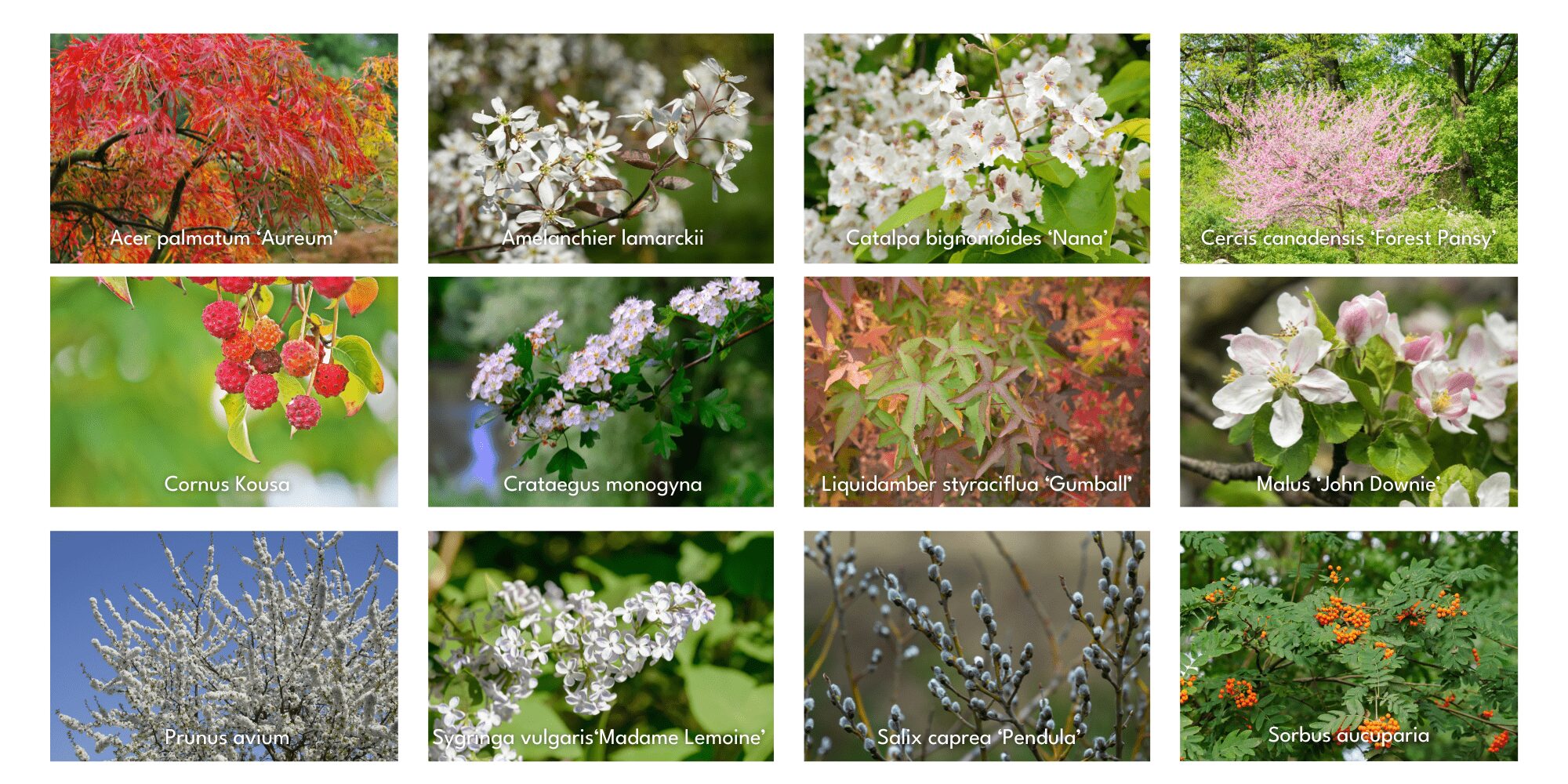Acer palmatum ‘Aureum’
Acers (Japanese Maples) come in all shapes and sizes. The word ‘palmatum’ means ‘five leaves’ – like the palm of a hand. Some cultivars have very finely ‘cut’ leaves, and they will be more prone to scorching and drying out in the wind. Always place your Acer in a partly shady spot well away from drying winds – preferably where you can see it from the house. This cultivar is a particularly lovely one, having stunning autumn colour. As the shape of an Acer is part of its appeal, be sure to pick out a specimen you love in person, from a specialist nursery – if you can. Acers are deciduous, losing their leaves in Autumn, but many have colourful or attractively peeling bark, so they hold their interest throughout the year.
Amelanchier lamarckii
The Juneberry is usually found as a multi-stemmed small tree. They can also produce suckers, which is part of their appeal, and doesn’t usually cause a problem. Juneberries have a long season of interest, having lovely blossom early in the spring, then richly coloured berries in the summer and autumn, then autumn colour when the leaves turn shades of red, orange, and purple. The stems will provide structural interest throughout the winter, when the birds will polish off any remaining berries.
Catalpa bignonioides ‘Nana’
The Indian Bean tree is mostly known for its species variety, which can grow very tall indeed. However, this smaller cultivar will behave much better in a small garden, still retaining the impressively large and interestingly shaped leaves, followed by the ‘beans’ – really seed pods. This tree is usually grown as a single stem, with the branches pruned to shape, or left to follow their natural shape. An unusual tree for a small garden.
Cercis canadensis ‘Forest Pansy’
The Eastern Redbud has two main areas of appeal – the pink flowers that come out before the leaves, and the lovely heart-shaped leaves themselves, turning from bronze when young, to yellow in the autumn. This small tree can be single or multi-stemmed, with some cultivars grafted onto a stem, allowing the branches to weep attractively. In the winter, the dark, reddish bark provides colour and interest until spring.
Cornus Kousa
There are many varieties of Chinese Dogwood – not to be confused with the shrub form known for brightly coloured bark in the winter. The main appeal of this tree is the huge amounts of blossom it will put out throughout the spring and early summer, covering the tree in a white or pinkish blanket. This is followed by pinkish fruits – not recommended as edible due to the large seeds and bitter rind, but brave souls may try. Trees can be multi-stemmed or single stemmed, and it is worthwhile going to a specialist tree nursery to pick out an attractive specimen.
Crataegus monogyna
The humble Hawthorn is often taken from granted, as it is so common in hedges throughout the countryside. However, the blossom covering the tree in spring is stunning, and modern cultivars have pink or reddish tinges to them, followed by the freely produced fruits (or haws) that will last all winter long if left by the birds. Although there are thorns, so this may not be suitable for a garden where there are young children, this lovely tree has so much else going for it that it should be possible to overlook its prickliness!
Liquidamber styraciflua ‘Gumball’
Another tree that in its species form will grow very tall, this cultivar is much more restrained. Almost always grown for its spectacular autumn colour, the Sweetgum has much else to recommend it. The leaves often lead to it being confused with Acers, having the same general arrangement. However, it can be easily identified from the middle – much longer leaflet, giving the whole leaf a much longer, more striking shape. Once the autumn show is over, the tree produces small, spiky fruits that are much loved by Goldfinches.
Malus ‘John Downie’
In my opinion, no garden is complete without a crab apple. This cultivar can be found grafted onto a dwarfing rootstock so that it stays within bounds, but still produces its distinctive large, yellow, and red fruits (crab apples). These can be made into the most delicious crab-apple jelly, or allowed to fall where they will provide autumn food for several different creatures. This tree can be trained to a fan or espalier shape, where the spring blossom can be fully appreciated, and pruned to give the most fruit. If well cared for, this tree will last for many years, becoming more attractive the more branched and gnarly it gets!
Prunus avium
The wild- or bird- cherry is another staple in hedgerows, but which also deserves a place in the garden, if only for the amazing amount of wildlife it will support. The spring blossom – white with a faint pinkish tinge – fades to long, elegant leaves, and the small bitter fruits in the autumn. They do not last long, as the birds will usually pick them off quickly, but there is some lovely autumn colour to be enjoyed, and the spreading branches cast dappled shade in the sun. Although it can be a little too large for very small gardens, newer cultivars such as ‘Plena’ can be smaller.
Sygringa vulgaris‘Madame Lemoine ’
A shamelessly showy and beautiful small tree, the White Lilac will be a talking point in even the smallest garden–even being happy in a large pot. Usually multistemmed, even the lovely structure of the properly pruned Lilac takes second place to the stunning scent when in flower. Although the Lilac takes centre stage when in flower, it retreats to the background for much of the rest of the year, making it a good partner for growing later-flowering clematis through it for later interest, or to pair with another small tree with good autumn colour
Salix caprea ‘Pendula’
The willow in its larger form is completely unsuited to smaller gardens. However, this weeping type is perfect, growing almost down to the ground if allowed. The branches have an attractive yellow colour, and the leaves are lovely, but it is the showy male catkins that this tree is usually grown for. Generally grafted onto a straight trunk, the stems will weep in a graceful arch, providing a lovely structural shape in the winter. As this tree will stay small with no extra pruning needed, it is particularly suited to very small gardens, where it can be a neat and well-behaved focal point.
Sorbus aucuparia
The Rowan, or Mountain Ash - with its bright spring blossom, autumn colour, and colourful berries lasting into the winter - certainly earns its place in the garden. But not only does it provide year-round interest, it is a powerhouse of support for wildlife, and a UK native as well. Usually grown with a single trunk, and an attractive crown of branches, this relatively slow-growing tree has enough varieties of blossom and berry colour to suit most gardens. Available from almost every nursery, it is worth finding your perfect colour combination and enjoying the Rowan for years to come.


